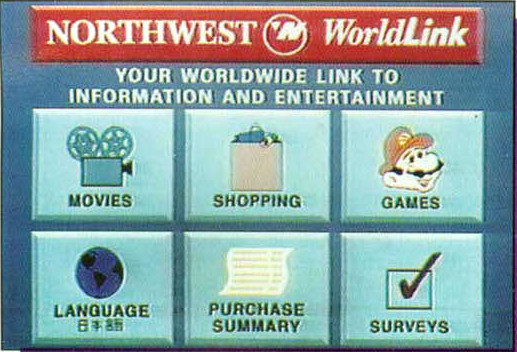The guy who didn't give up on in-flight movies even when the airlines told him it was too hard
— George Sahler, a former chairman of the World Airline Entertainment Association and an in-flight entertainment manager at Lufthansa, discussing in a 1986 Los Angeles Times interview the move toward multiple large screens on planes. Sahler predicted that within a decade or so that many flights would have small individual screens built into the seats, which would allow people to watch customized programming for their own personal tastes, along with live television programming beamed to the planes via satellite—two predictions that quickly became true."These TV screens, about one every six or seven rows of seats, provide much better resolution than the current video projection system. The resolution will also be better than that found on the TV sets in most American homes."
One notable in-flight entertainment system is based on the Super NES (really)
And this thing didn't just play video games, either—it also allowed for movies, music, phone calls, shopping, and access to information. Heck, it even allowed for faxes. (That meant the controller was more like a remote control combined with a phone, combined with a controller.) And on top of that, this multifunction monstrosity had to pass rigorous testing from regulatory bodies like the Federal Aviation Administration.Since space is at a premium on planes, all the components that normally fit inside your Super NES Control Deck had to be fit into a three and a half inch square that is one inch thick. To accomplish that miraculous feat, the engineers at NOA had to use many new parts. They also had to work with a different power supply that called for more efficient components. The most obvious difference between the Gateway System and the Super NES is that you can't plug a Game Pak into the Gateway. Instead, game programs are downloaded into a two megabyte RAM (Random Access Memory.) That's enough memory to hold the massive 16 megabit games that are becoming more commonplace.
Obviously, all of the above ideas for getting entertainment onto planes were awesome way back when.But investing in these types of devices is hard to justify in an age when literally every device being brought on a plane is nearly as good, if not better.And there's a good reason the tablet or laptop you're carrying with you is so good in comparison. Per Fast Company, that single-screen getup in front of your face while you're in economy class? That costs something like $10,000, with the remote adding couple thousand more to the price.Why the high cost? Everything needs to get tested by the FAA to ensure it won't endanger the plane, and because the system gets updated so infrequently, airlines tend to future-proof by buying technology that won't go out of date right away.But it does eventually go out of date. The reason why the plane version of the Nintendo Gateway System was stuck on the Super NES while hotels had access to the GameCube? Simple: Northwest Airlines (and other airlines that used the system) didn't want to have to pay another million and a half bucks per plane to upgrade. When it's a seven-digit expense, you want to minimize the pain. We get it.The logic of getting rid of these things is pretty good: Offering basically the same service through high-speed WiFi is simply going to be cheaper, you're cutting down on the amount of weight on the plane (which saves on fuel costs), and for people who don't have smartphones, you can make a little money simply by renting out a few tablets. And, most notable of all, The New York Times notes that one-tenth of the cost of the average passenger plane goes to in-flight entertainment. That's crazy! So it's good we're starting to lose these relics that reflect just how captive the audience is on a long flight. The question, of course, is this: If they get rid of them, will they give us a little extra leg room in return?
